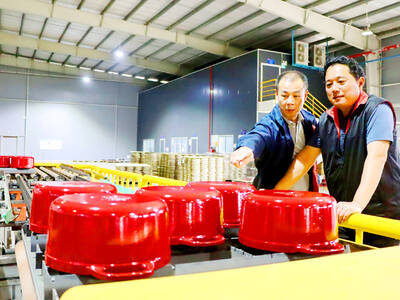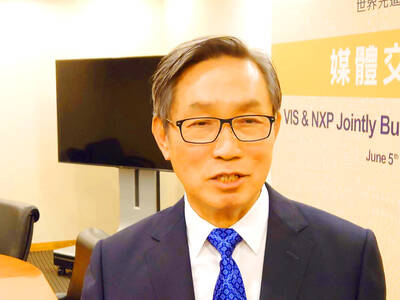Google Inc launched an open data platform yesterday to share information on natural disasters in Taiwan such as typhoons and floods, with the aim of building the country into a model area for the cloud computing-based system.
Taiwan is the second Asian country to adopt the platform in partnership with government authorities after a similar launch in Japan in March this year, Google Taiwan managing director Chien Lee-feng (簡立峰) said.
“This represents Google’s commitment to Taiwanese users and shows the government’s efforts to release open data and build a more localized crisis response system,” Chien said at a press conference to announce the platform.

Photo: CNA
For example, when a typhoon strikes Taiwan, people will be able to access the platform through Google Maps or Google Search services on computers or mobile devices to find information such as the typhoon path, affected areas and nearby places of refuge.
Users can also share disaster information on social network sites such as Facebook or Google Plus, Google said.
“As Taiwan heads into another typhoon season, the need for reliable and easily accessible information about where the next storm will hit and how to stay safe has never been more important. That’s why we’re launching Google Public Alerts and a dedicated Google Crisis Map for Taiwan,” the global search engine giant said in a blog. “Starting today, relevant severe weather alerts for typhoons and flood-related events in Taiwan will appear on the Google Public Alerts page as well as on Google Search, Google Maps and Google Now.”
The data will be provided by government agencies including the Central Weather Bureau, the Water Resources Agency, the Soil and Water Conservation Bureau, the Directorate General of Highways and the National Science and Technology Center for Disaster Reduction.
Minister Without Portfolio Simon Chang (張善政), a former Google executive, said at the press conference that with this crisis response platform, the government expects to help more people avoid the upheaval brought by natural disasters.
He said that Google and the government are also working on an open data system for earthquake information that will be integrated into the crisis alert platform in the future.

TAKING STOCK: A Taiwanese cookware firm in Vietnam urged customers to assess inventory or place orders early so shipments can reach the US while tariffs are paused Taiwanese businesses in Vietnam are exploring alternatives after the White House imposed a 46 percent import duty on Vietnamese goods, following US President Donald Trump’s announcement of “reciprocal” tariffs on the US’ trading partners. Lo Shih-liang (羅世良), chairman of Brico Industry Co (裕茂工業), a Taiwanese company that manufactures cast iron cookware and stove components in Vietnam, said that more than 40 percent of his business was tied to the US market, describing the constant US policy shifts as an emotional roller coaster. “I work during the day and stay up all night watching the news. I’ve been following US news until 3am

Six years ago, LVMH’s billionaire CEO Bernard Arnault and US President Donald Trump cut the blue ribbon on a factory in rural Texas that would make designer handbags for Louis Vuitton, one of the world’s best-known luxury brands. However, since the high-profile opening, the factory has faced a host of problems limiting production, 11 former Louis Vuitton employees said. The site has consistently ranked among the worst-performing for Louis Vuitton globally, “significantly” underperforming other facilities, said three former Louis Vuitton workers and a senior industry source, who cited internal rankings shared with staff. The plant’s problems — which have not

TARIFF CONCERNS: The chipmaker cited global uncertainty from US tariffs and a weakening economic outlook, but said its Singapore expansion remains on track Vanguard International Semiconductor Corp (世界先進), a foundry service provider specializing in producing power management and display driver chips, yesterday withdrew its full-year revenue projection of moderate growth for this year, as escalating US tariff tensions raised uncertainty and concern about a potential economic recession. The Hsinchu-based chipmaker in February said revenues this year would grow mildly from last year based on improving supply chain inventory levels and market demand. At the time, it also anticipated gradual quarter revenue growth. However, the US’ sweeping tariff policy has upended the industry’s supply chains and weakened economic prospects for the world economy, it said. “Now

COLLABORATION: Given Taiwan’s key position in global supply chains, the US firm is discussing strategies with local partners and clients to deal with global uncertainties Advanced Micro Devices Inc (AMD) yesterday said it is meeting with local ecosystem partners, including Taiwan Semiconductor Manufacturing Co (TSMC, 台積電), to discuss strategies, including long-term manufacturing, to navigate uncertainties such as US tariffs, as Taiwan occupies an important position in global supply chains. AMD chief executive officer Lisa Su (蘇姿丰) told reporters that Taiwan is an important part of the chip designer’s ecosystem and she is discussing with partners and customers in Taiwan to forge strong collaborations on different areas during this critical period. AMD has just become the first artificial-intelligence (AI) server chip customer of TSMC to utilize its advanced